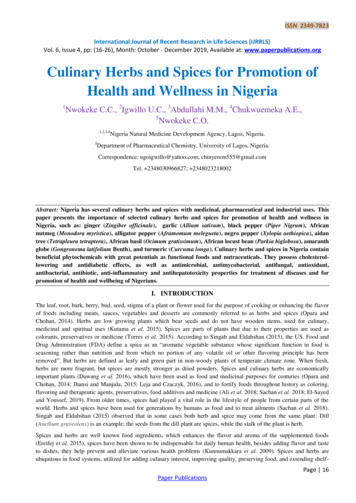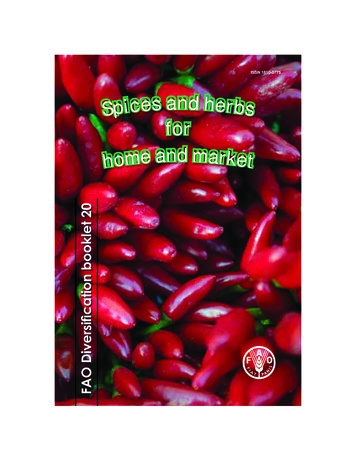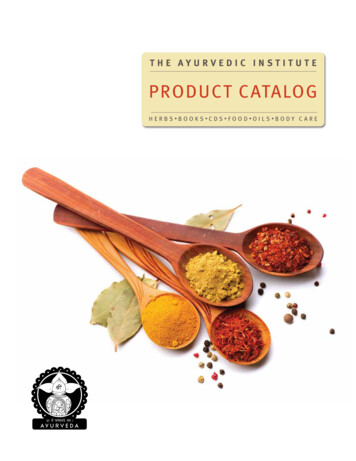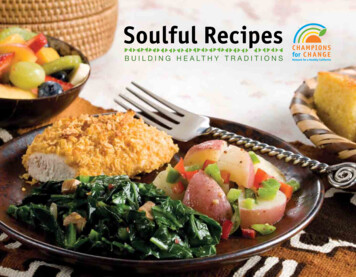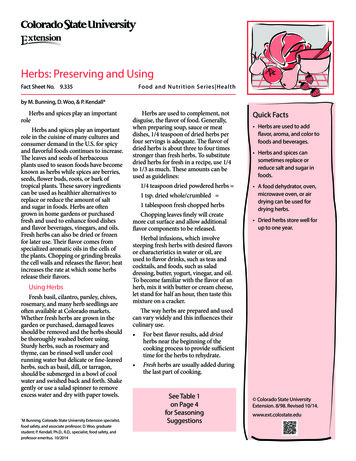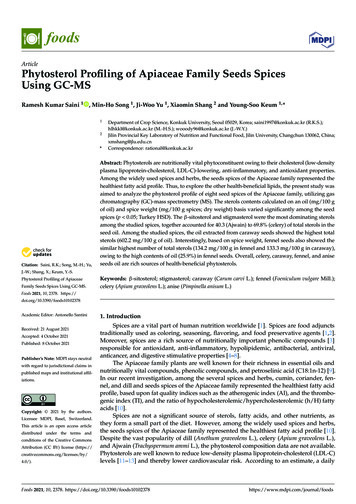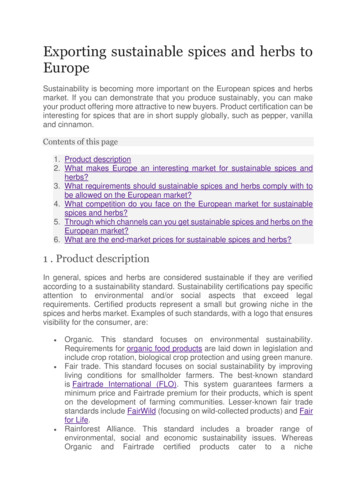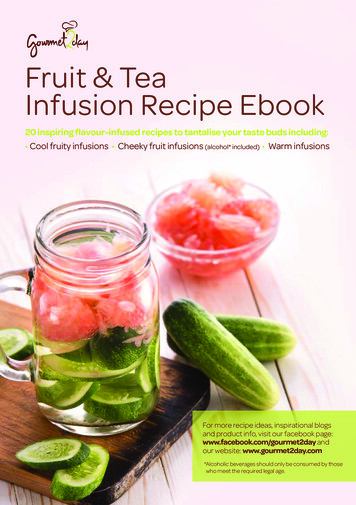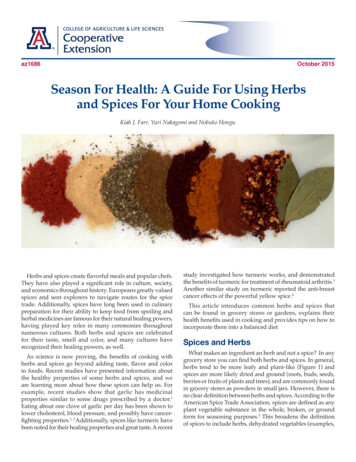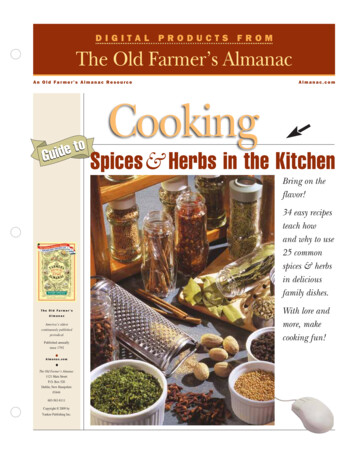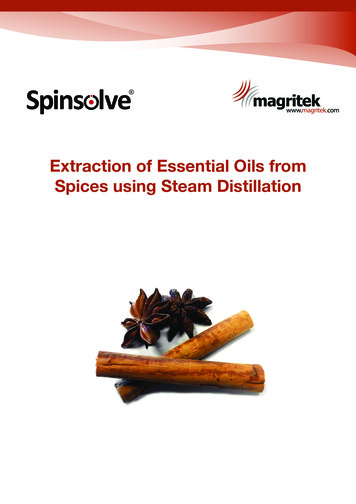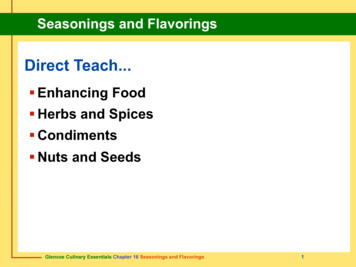
Transcription
Seasonings and FlavoringsDirect Teach. Enhancing Food Herbs and Spices Condiments Nuts and SeedsGlencoe Culinary Essentials Chapter 16 Seasonings and Flavorings1
Seasonings and FlavoringsEnhancing Food Seasonings and flavorings strengthen afood’s natural flavor. Knowing which seasonings and flavoringswork well with certain food items is animportant cooking skill.Glencoe Culinary Essentials Chapter 16 Seasonings and Flavorings2
Seasonings and FlavoringsSeasonings and Flavorings To strengthen food’s natural flavors, foodserviceprofessionals use: SeasoningsSeasoningAn ingredient that enhances foodwithout changing the natural flavor.Glencoe Culinary Essentials Chapter 16 Seasonings and Flavorings3
Seasonings and FlavoringsSeasonings and Flavorings To strengthen food’s natural flavors, foodserviceprofessionals use: Flavor enhancersFlavor enhancersIncreases the way you perceive thefood’s flavor without changing theactual flavor of the prepared dish.Glencoe Culinary Essentials Chapter 16 Seasonings and Flavorings4
Seasonings and FlavoringsSeasonings and Flavorings To strengthen food’s natural flavors, foodserviceprofessionals use: FlavoringsFlavoringAn ingredient that actually changesthe natural flavor of the foods to whichit is added.Glencoe Culinary Essentials Chapter 16 Seasonings and Flavorings5
Seasonings and FlavoringsSeasonings and Flavorings To strengthen food’s natural flavors, foodserviceprofessionals use: ExtractsExtractsA concentrated flavor such as almondand vanilla are flavorings.Glencoe Culinary Essentials Chapter 16 Seasonings and Flavorings6
Seasonings and FlavoringsSeasonings and Flavorings Salt is the most commonlyused seasoning today. Common salts used byfoodservice professionalsinclude: table salt rock salt sea salt kosher saltGlencoe Culinary Essentials Chapter 16 Seasonings and Flavorings7
Seasonings and FlavoringsSeasonings and Flavorings Pepper is the most widely used spice inthe world. Peppercorns can be black, white, green, and red;red is more closely related to bell peppers.spiceA flavoring that blends with thenatural flavor of foods.Glencoe Culinary Essentials Chapter 16 Seasonings and Flavorings8
Seasonings and FlavoringsSeasonings and Flavorings Hot peppers are called chiles and vary in theirdegree of hotness, color, and flavor. Always wear gloves when working with hotpeppers to prevent burns.Glencoe Culinary Essentials Chapter 16 Seasonings and Flavorings9
Seasonings and FlavoringsSeasonings and Flavorings Onions are a flavoring froma family that also includes: scallions leeks shallots chives garlicGlencoe Culinary Essentials Chapter 16 Seasonings and Flavorings10
Seasonings and FlavoringsSeasonings and Flavorings Lemon is a flavoring from the zest of the fruit,added to dishes such as fish, meats, vegetables,and desserts.zestThe rind of a fruit.Glencoe Culinary Essentials Chapter 16 Seasonings and Flavorings11
Seasonings and FlavoringsSeasonings and Flavorings Monosodium glutamate, or MSG, is a type of saltthat comes from seaweed. It intensifies thenatural flavor of most of the foods to which it isadded.Glencoe Culinary Essentials Chapter 16 Seasonings and Flavorings12
Seasonings and FlavoringsSeasonings and Flavorings Seasonings can be added at any time duringcooking, but some forms of food adaptthemselves to seasoning at certain times. Flavorings can be added during the cookingprocess at any time, but effects on preparedfoods will depend on cooking time.What dishes have you madethat required seasoningsand flavorings?Glencoe Culinary Essentials Chapter 16 Seasonings and Flavorings13
Seasonings and FlavoringsHerbs and Spices A foodservice employee must be able toidentify and use herbs and spices. Correctly used, herbs and spices canenhance a dish. Incorrectly used, herbs and spices canruin a dish.Glencoe Culinary Essentials Chapter 16 Seasonings and Flavorings14
Seasonings and FlavoringsHerbs Foodservice professionals need to know whatherbs and spices look like, what flavors theyhave, and how to correctly use them.herbA plant that grows in temperateclimates; used as flavoring thatadds color and aroma to foods.Glencoe Culinary Essentials Chapter 16 Seasonings and Flavorings15
Seasonings and FlavoringsHerb Varieties Examples of herbs include: basil garlic chives bay leaf lemongrass chervil marjoram chives mint cilantro oregano dill parsleyGlencoe Culinary Essentials Chapter 16 Seasonings and Flavorings rosemarysagesavorytarragonthyme16
Seasonings and FlavoringsHerb Use Herbs can can be used with a variety ofcold and hot dishes.Glencoe Culinary Essentials Chapter 16 Seasonings and Flavorings17
Seasonings and FlavoringsHerb Use Herbs can have adelicate or bold flavor. Fresh herbs are not asstrong, so twice theamount should beused if dried herbs arecalled for in a recipe.Glencoe Culinary Essentials Chapter 16 Seasonings and Flavorings18
Seasonings and FlavoringsHerb Use Herbs should be minced or crushed as close tocooking or serving time as possible. Herbs often need plenty of time to release theirflavor to cold foods. Dried herbs should be addedat the beginning of or during the cooking process.Use a little and taste before you add more, usingtoo much can ruin the dishGlencoe Culinary Essentials Chapter 16 Seasonings and Flavorings19
Seasonings and FlavoringsHerb Use Cold Foods - Salads, Salsa Hot Foods - Lamb with Rosemary, Basil withTomato Sauce Sachet - French for a bag. Often filled with freshherbs - cloves, garlic, crushed peppercorns Bouquet Garni - combination of fresh herbs andveggies tied in a bundle. The bundle is simmeredin the pot before the dish is served.Glencoe Culinary Essentials Chapter 16 Seasonings and Flavorings20
Seasonings and FlavoringsHerb Storage Store fresh herbs wrapped loosely in damp papertowels on sheet pans in a refrigerator. Store dried herbs in containers that are opaqueand airtight, in a cool, dry place at temperaturesbetween 50 F (10 C) and 70 F (21 C)Glencoe Culinary Essentials Chapter 16 Seasonings and Flavorings21
Seasonings and FlavoringsSpices Spices come from the bark, buds, fruits, roots,seeds, or stems of plants and trees. Spices can be used whole,ground, sliced,or in chunks. The form you use dependson the cooking time.Glencoe Culinary Essentials Chapter 16 Seasonings and Flavorings22
Seasonings and FlavoringsSpice Varieties Examples of spices include: allspice cayenne anise seeds cumin cardamom chiles cinnamon dill seeds celery seeds fennel seeds chili powder saffronGlencoe Culinary Essentials Chapter 16 Seasonings and Flavorings pepper nutmeg mustardseeds paprika ginger23
Seasonings and FlavoringsSpice Usage Whole - Poach fruit, marinade Cold Foods - Add spices to cold food severalhours before serving time. Can be added for color - saffron is used to givepaella a yellowish color. Ground spices release their flavor immediately.Add ground spices near the end of cooking. Always measure carefully. They should notdominate the food but compliment it.Glencoe Culinary Essentials Chapter 16 Seasonings and Flavorings24
Seasonings and FlavoringsSpice Storage Spices should be stored in airtight containersaway from direct sunlight and in cool, dry place attemperatures of 50 F (10 C) to 70 F (21 C).Glencoe Culinary Essentials Chapter 16 Seasonings and Flavorings25
Seasonings and FlavoringsCondiments, Nuts, and Seeds Condiments, nuts, and seeds can be servedwith food to enhance flavor. Condiments are added to prepared food,while nuts and seeds are usedduring cooking.Glencoe Culinary Essentials Chapter 16 Seasonings and Flavorings26
Seasonings and FlavoringsCondiment Varieties Condiments are served with food to helpenhance food flavors.condimentSomething served as anaccompaniment.Glencoe Culinary Essentials Chapter 16 Seasonings and Flavorings27
Seasonings and FlavoringsCondiment VarietiesDescribe these different condiments.CondimentDescriptionSalsaA fresh or cooked mixture of rough chopped chiles, tomatoes,onions, and cilantroKetchupA tomato-based sauce that has a tangy, sweet-and-sour taste;some ketchups have a flavoring added, such as jalapeñoSteak SauceA sauce that is tangier than ketchup; often used with grilled orbroiled meatsGlencoe Culinary Essentials Chapter 16 Seasonings and Flavorings28
Seasonings and FlavoringsCondiment VarietiesDescribe these different condiments.CondimentDescriptionPrepared MustardContains a combination of ground white, black, and brownmustard seeds, vinegar, salt and spices; comes in manytextures and flavorsVinegarA sour, acidic liquid used in cooking, marinades, and saladdressings; varieties include white, red wine, balsamic, andcider vinegarsFlavored OilAn oil that has been enhanced with ingredients such as herbs,spices, and garlicGlencoe Culinary Essentials Chapter 16 Seasonings and Flavorings29
Seasonings and FlavoringsCondiment Storage Unopened should be stored in cool and dryareas. Opened should be stored in the refrigerator.Glencoe Culinary Essentials Chapter 16 Seasonings and Flavorings30
Seasonings and FlavoringsNuts and Seeds Nuts and seeds can be used to: enhance natural flavor add color add texture to food. Seed can be used: during cooking (cumin) for baking (poppy seeds)Glencoe Culinary Essentials Chapter 16 Seasonings and Flavorings31
Seasonings and FlavoringsNuts and Seeds Nuts and seeds add B vitamins Vitamin E Protein and essential fatty acids Nuts and seeds provide A way to reduce the risk of heart disease byup to 10 percent.Glencoe Culinary Essentials Chapter 16 Seasonings and Flavorings32
Glencoe Culinary Essentials Chapter 16 Seasonings and Flavorings Seasonings and Flavorings 13 Seasonings can be added at any time during cooking, but some forms of food adapt themselves to seasoning at certain times. Flavorings can be added during the cooking process at any time, b
